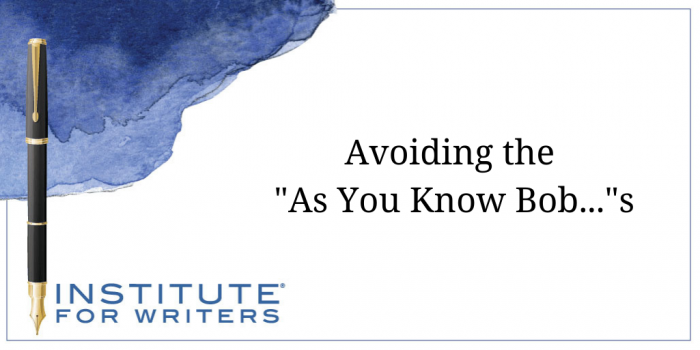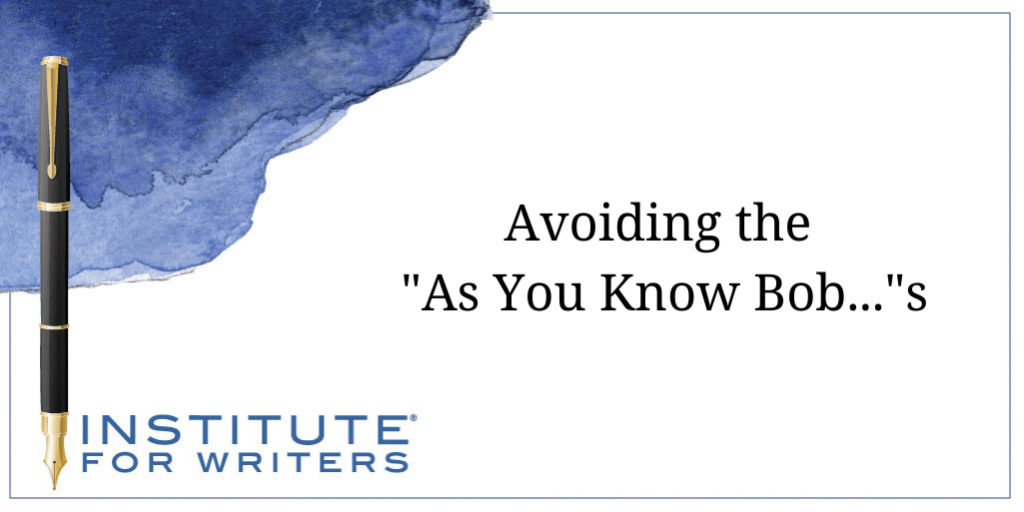
- Date: January 14, 2020
- Author: Jamie K. Schmidt
- Category: Writing for Adults Blog
- Tags: Backstory, Craft, novels, writing craft
We teach our students how to write and get published!
View our Course Catalog >
Avoiding the “As You Know Bob…”s
The right way to add backstory to your dialogue
In any piece of fiction, every word must count. And dialogue should do many things at once to be effective. Dialogue needs to serve a purpose, such as moving the story along, showing character, or providing information. But if you can seed a little bit of each in the conversation, then you have a meaningful exchange that the readers won’t skim over for fear of missing the good stuff.
Avoid Info Dumps
You don’t want the clunky “this happened, then that happened, and then her uncle—her mother’s estranged brother—showed up.” That’s giving all the information as a list, whereas what you want is to reveal it as part of the natural storytelling. You do need to include pertinent information, but not at the cost of smooth transitions, or believable dialogue.
While your dialogue should progress the narrative, it can’t be a way to info dump backstory or information the character should know, but the reader doesn’t. Writers call this the “As you know Bob…” mistake. For example:
“So, as you know, Carol, my mother, Helen, died suddenly—without warning. I came back here to New Paltz, New York for the funeral after staying away for several years. I felt an obligation to put her affairs in order. She left me her house on Main Street that’s been haunted since you and I were kids, and now I have to find a way to drive the spirit out so I can take back my family home.”

Other fixes to this dialogue would be to remove mention of the city, state, and the Main Street address. Carol knows all this. And also, take out the mother’s name. Carol is obviously a friend and would know who Helen was, that she recently died, and probably that she did so without warning. The only person who doesn’t know this is the reader and those details can be sprinkled in later.
“Carol, remember back in 1980 when we were playing around with the Ouija board and I said I moved the planchette? Well, I didn’t. I was too scared to tell you that an evil spirit came through the board that night and he’s been haunting the house ever since. I escaped from it as soon as I could. But Mom stayed. I think it killed my mother to bring me back here.”
In the above rewrite of the paragraph, the dialogue ends in a mini cliffhanger, leaving the reader wanting answers to some pretty big questions. Also, it brings Carol into the story as an accomplice. Would the evil spirit have come through if they hadn’t been playing around? The reader is encouraged to read on to find out.
However, sometimes you can get away with a little “As you know, Bob.” One famous example of this is in the movie The Matrix when Neo and Morpheus, two computer hackers/experts are talking. Morpheus says something along the lines of “that’s when the AI took over.” And Neo says, “AI? Artificial Intelligence?” Any person well versed in computers knows what AI means, so that explanation was for the audience. It works because it’s short. But it still popped me out of the narrative because they were acting against character. In a real dialogue between computer experts, there would be no need to explain what AI stood for.
Backstory Dialogue Tips
So how do you avoid info dumping and “As you know Bobbing”?
1. Make sure that your dialog is not a block of text. Dialog should flow back and forth between two (or more people). No one wants to listen to a speech in a book of fiction. William Shakespeare could get away with monologuing back then, but in modern times he would run the risk of losing the reader.
2. Don’t state things that the person the narrator is talking to already knows. If you find yourself writing, “As you know…” skip what you were about to write next.
3. Save the backstory for the narrative and drop it in sparingly.
4. Pay attention to the rhythm of how people speak. They don’t always use complete sentences. Don’t feel locked in to documenting everything that happens when two people start a conversation. Feel free to start in the middle and let the reader catch up.
Once you avoid info dumps and delete the conversation that duplicates what the reader already knows, you’ll be a few steps ahead of tightening up your dialogue and making the story flow more naturally.
Related Posts on Backstory
USA Today bestselling author, Jamie K. Schmidt, writes erotic contemporary love stories and paranormal romances. Her steamy, romantic comedy, Life’s a Beach, reached #65 on USA Today, #2 on Barnes & Noble and #9 on Amazon and iBooks. Her Club Inferno series from Random House’s Loveswept line has hit both the Amazon and Barnes & Noble top one hundred lists. The first book in the series, Heat, put her on the USA Today bestseller list for the first time, and is a #1 Amazon bestseller. Her book Stud is a 2018 Romance Writers of America Rita® Finalist in Erotica. Her dragon paranormal romance series has been called “fun and quirky” and “endearing.” Partnered with New York Times bestselling author and actress, Jenna Jameson, Jamie’s hardcover debut, SPICE, continues Jenna’s FATE trilogy.
Become a better writer today
1000 N. West Street #1200, Wilmington, DE 19801
© 2024 Direct Learning Systems, Inc. All rights reserved.
1000 N. West Street #1200, Wilmington, DE 19801
© 2024 Direct Learning Systems, Inc. All rights reserved.
1000 N. West Street #1200, Wilmington, DE 19801
© 2024 Direct Learning Systems, Inc. All rights reserved.














1 Comment